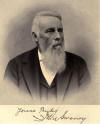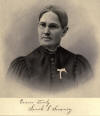
 John
SWANEY, a farmer living on section 15, Magnolia township, where
he owns a valuable and well improved tract of land, was born at
Harrisburg, Pennsylvania, October 8, 1824, and in the paternal
line comes of Irish descent. His parents were James and Nancy.
(RALEY) SWANEY, the former born on the Emerald isle, while the
latter was born in Washington county, Pennsylvania. Her father,
Eli RALEY, belonged to an old Virginia family, and was a member
of the Society of Friends, or Quakers. The parents were married
in the Keystone state and made their home in Harrisburg until
the father's death, which occurred in 1829. Four years later the
mother removed with her family to Washington county, that state,
and there became the wife of James MOFFITT. In 1842 the family
made their way westward to Illinois, where they settled on a
farm in Magnolia township, Putnam county, and here the mother
passed away in 1872. By her first marriage she was the mother of
three sons: John, of this review; David, of Nebraska; and
Barnett, a resident of La Salle county, Illinois. By her
marriage to Mr. MOFFITT she had one son, Eli MOFFITT, who is a
resident of Adrian, Michigan. Three of the sons were loyal
defenders of the Union cause during the Civil war, while the
fourth furnished a substitute.
John
SWANEY, a farmer living on section 15, Magnolia township, where
he owns a valuable and well improved tract of land, was born at
Harrisburg, Pennsylvania, October 8, 1824, and in the paternal
line comes of Irish descent. His parents were James and Nancy.
(RALEY) SWANEY, the former born on the Emerald isle, while the
latter was born in Washington county, Pennsylvania. Her father,
Eli RALEY, belonged to an old Virginia family, and was a member
of the Society of Friends, or Quakers. The parents were married
in the Keystone state and made their home in Harrisburg until
the father's death, which occurred in 1829. Four years later the
mother removed with her family to Washington county, that state,
and there became the wife of James MOFFITT. In 1842 the family
made their way westward to Illinois, where they settled on a
farm in Magnolia township, Putnam county, and here the mother
passed away in 1872. By her first marriage she was the mother of
three sons: John, of this review; David, of Nebraska; and
Barnett, a resident of La Salle county, Illinois. By her
marriage to Mr. MOFFITT she had one son, Eli MOFFITT, who is a
resident of Adrian, Michigan. Three of the sons were loyal
defenders of the Union cause during the Civil war, while the
fourth furnished a substitute.
John SWANEY, whose name introduces this review, accompanied his maternal grandfather, Eli RALEY, to Putnam county in 1840, being then a youth of sixteen years. His education, begun in his native state, was continued in a log schoolhouse near the home of his grandfather in Putnam county, his teacher being the late Judge BURNES of Marshall county, this state. Mr. SWANEY was reared to agricultural life, early becoming familiar with the various duties which fall to the lot of the farmer, and in early life he learned the wagonmaker's trade, serving a three-years' apprenticeship, after which he followed the trade for two years. In 1847 he began steamboating on the Illinois river, serving as second clerk on the Anglo-Saxon, running from St. Louis to La Salle. He was later promoted to the position of first clerk and served in that capacity until the breaking out of the rebellion, being employed on various boats which plied the Illinois, Ohio and upper and lower Mississippi and Missouri rivers.
In October, 1861, his patriotic spirit being aroused by the continued attempt of the south to overthrow the Union, Mr. SWANEY made application to enter the navy at St. Louis with Commodore ROGERS, and was commissioned as acting master and ordered to the receiving ship, Maria Denning, where he began his naval drill. Later the Maria Denning was sent to Cairo, Illinois, carrying the ordinance to equip iron clad gunboats, built at St. Louis. After the battle of Fort Donelson he was transferred to the gunboat Cairo, which was ordered to Nashville, accompanying General NELSON. His company were at Pittsburg Landing, later at the bombardment of Fort Pillow above Memphis, in which they took part. After the naval battle at Memphis, where the rebel gunboats were destroyed or captured, they were ordered back to Cairo. Acting Master SWANEY was then transferred to the Conestoga, under command of Lieutenant Commander, later Admiral, Selfridge, now a retired rear admiral of Boston, and his vessel was one of the number engaged in cruising from the mouth of White river down the Mississippi river to Columbia, Arkansas, a distance of sixty miles, the river being divided into naval divisions by Admiral Porter. He was subsequently transferred to the United States steamer, Kenwood, which he commanded with the rank of acting volunteer lieutenant until August, 1865, operating on the Mississippi river from the mouth of Red river to Baton Rouge and Donnellsonville. He dismantled his steamer at Cairo in August, 1865, but was not discharged until the following October, when he returned home after four years of faithful and arduous service.
After his return from the navy Mr. SWANEY resumed his farming operations, taking up his abode on the farm which has since continued to be his home. Through a long period he was actively engaged in farm labor and has been an active and helpful factor in the development and upbuilding of this portion of the state. As the years passed he prospered in his undertakings so that he added from time to time to his landed possessions and today is in possession of a valuable and well-improved farm, on which he still makes his home, although he rents the land, and from this he derives an income sufficient to supply himself and wife with all the comforts and many of the luxuries of life, so that now in their declining years they may live in well earned ease.
 On
the 17th of May, 1846, Mr. SWANEY chose as a companion and
helpmate on life's journey Miss Sarah GRIFFITH, a native of
Cadiz, Ohio, born on the 12th of October, 1830. Her parents,
George and Sarah (KIRK) GRIFFITH, were both natives of York
county, Pennsylvania, where they were reared and married, and on
leaving the Keystone state removed to Cadiz, Ohio, where they
made their home for a few years, but in 1836 made their way to
Putnam county, Illinois, settling on a farm on section 15,
Magnolia township, known as the Whitaker farm. Their first
residence was a log house, which was later replaced by a more
substantial and commodious brick residence, the brick and lime
for its construction being burned by Mr. GRIFFITH. Mrs. GRIFFITH
passed away May 24, 1838, and was the first adult buried in the
Friends cemetery. She had become the mother of ten children, but
with the exception of two all are now deceased: Isaac, William
and Julia Ann, all deceased; Martha Jane, residing in Marshall
county, Iowa; Oliver G., George and John, all of whom are
deceased; Sarah, now Mrs. SWANEY; and Eliza and Ruth, deceased.
After the mother's death the father was married again, his
second union being with Lydia COMLY, and he is still living and
was ninety years old November 24, 1906. To this union four
children were born: Hiram, of Montana; one who died in infancy;
Frank, also residing in Montana; and Mrs. Isabel BECK of
Magnolia township, Putnam county.
On
the 17th of May, 1846, Mr. SWANEY chose as a companion and
helpmate on life's journey Miss Sarah GRIFFITH, a native of
Cadiz, Ohio, born on the 12th of October, 1830. Her parents,
George and Sarah (KIRK) GRIFFITH, were both natives of York
county, Pennsylvania, where they were reared and married, and on
leaving the Keystone state removed to Cadiz, Ohio, where they
made their home for a few years, but in 1836 made their way to
Putnam county, Illinois, settling on a farm on section 15,
Magnolia township, known as the Whitaker farm. Their first
residence was a log house, which was later replaced by a more
substantial and commodious brick residence, the brick and lime
for its construction being burned by Mr. GRIFFITH. Mrs. GRIFFITH
passed away May 24, 1838, and was the first adult buried in the
Friends cemetery. She had become the mother of ten children, but
with the exception of two all are now deceased: Isaac, William
and Julia Ann, all deceased; Martha Jane, residing in Marshall
county, Iowa; Oliver G., George and John, all of whom are
deceased; Sarah, now Mrs. SWANEY; and Eliza and Ruth, deceased.
After the mother's death the father was married again, his
second union being with Lydia COMLY, and he is still living and
was ninety years old November 24, 1906. To this union four
children were born: Hiram, of Montana; one who died in infancy;
Frank, also residing in Montana; and Mrs. Isabel BECK of
Magnolia township, Putnam county.
Mr. SWANEY first gave his support to the abolition party and afterward to the republican party, but is now a prohibitionist, thus indicating his views on the temperance question. He has always taken a very deep and helpful interest in the advancement of this party and has frequently attended its district, state and national conventions. In 1885 his name was placed before the public on both the republican and prohibition tickets as a candidate for state senator, but as his party was in the minority at that time he was defeated in election. In former years he frequently contributed to agricultural journals, thus taking a deep interest in the agricultural development of his part of the state. He was instrumental in securing the postoffice at Clear Creek, which was first called Whitaker, and for twenty-one years served as postmaster.
In 1866 he was assistant United States revenue assessor, and in educational affairs has taken a helpful interest. For many years he served as school trustee of Magnolia township, and in 1905 he donated twenty-four acres of land for the establishment of a new consolidated district school, three districts uniting. A large and commodious brick building is now under construction and when completed will be one of the finest in Putnam county. Mr. SWANEY employed a landscape artist from Chicago to lay out the grounds so that they are most beautifully and tastefully arranged. The children are taken to school in covered wagons, which have been built expressly for that purpose. Thus it will be seen that Mr. SWANEY is a warm friend to the cause of education and his efforts in the cause of educational system are proving of great benefit to the youth of this community. Mrs. SWANEY, like her parents, is a devoted member of the Society of Friends and both she and her husband are charter members of the Magnolia Grange, in which she has held office, while he has filled all of the chairs in the organization. He has also served as a member of the State Grange executive committee and was also identified with the first organization of the Grand Army post at Magnolia. Mr. SWANEY has now passed the eighty-second milestone on life's journey and has lived in Putnam county for sixty-six years, so that he is thoroughly familiar with the pioneer conditions which existed in this community at that early day. He and his wife are venerable and highly respected people of this portion of the state and number their friends by the score.
Extracted July 2011 by Norma Hass from Past and Present of Marshall and Putnam Counties Illinois, 1907.
| Bureau Putnam La Salle | |||
| Stark |
 |
||
| Peoria | Woodford | ||

